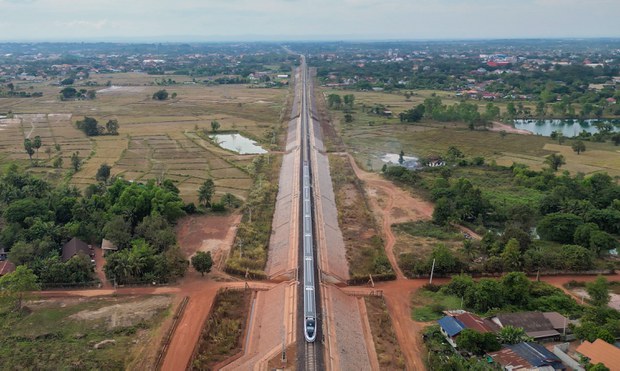Some villagers in Vientiane holding out for higher Laos-China railway payout
Share

A train runs on the China-Laos Railway in the suburbs of Vientiane, Laos, Nov. 28, 2022.
Most villagers affected by construction of the Vientiane section of the Laos-China high speed railway project have accepted compensation for their land but about a fifth are holding out for more money, a government official told Radio Free Asia.
A remaining 18 percent of villagers near the capital have said that the amount of offered compensation is too low compared to market value, according to Bouavone Souklaseng, head of the Vientiane Capital Planning and Investment Department, who spoke to a people’s council meeting on Wednesday.
One villager told Radio Free Asia that the people in her village are still negotiating the price with related officials. They’ve been offered 80,000 kip (about USD$4.12) per meter, but they’re asking for 150,000 kip (about USD$7.70) per meter, she said.
“Some of them have waited for five years already,” she said.
Another affected villager who is still awaiting compensation said authorities have told her not to criticize the government on social media about the late payments.
The US$6 billion railway connecting the two Communist neighbors opened in December 2021. The World Bank estimated that it would boost tourism, freight transport and trade in agriculture.
The line runs from Vientiane into northern Laos, passing through 10 stations in the country, including the major tourist draw of Luang Prabang and the Chinese border town of Boten. It ends in Kunming in the southwestern Chinese province of Yunnan.
It’s the first railroad to penetrate any distance into Laos, a country whose transport infrastructure has long been constrained by poverty, mountainous terrain and sparse population.
But the project has been criticized for displacing several thousand farmers from their land. Many have faced long delays in getting reimbursement for their lost property, as others have been shortchanged in the payments they did receive.
In Vientiane, there are 1,738 pieces of land affected by the rail line construction. Out of these, 1,430 landowners have received compensation and 308 landowners are still in negotiation, the chairman of the Laos state inspection authority said at a recent National Assembly meeting.
There were about 6,855 families nationwide affected by the Lao-China rail line construction in four provinces, with 5,837 families already receiving compensation, according to the chairman, Khamphanh Phommathat.
Translated by Sidney Khotpanya. Edited by Matt Reed.







